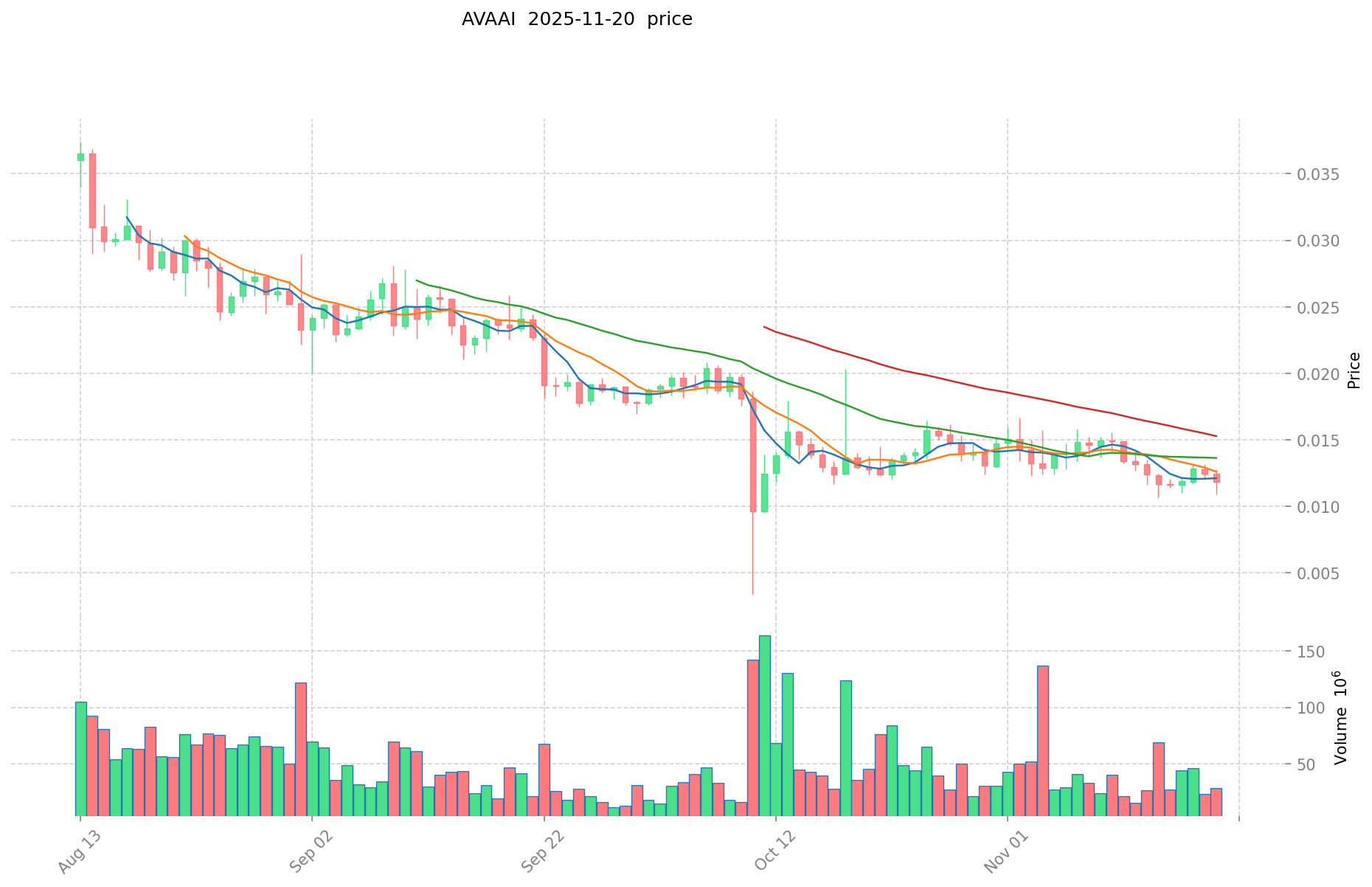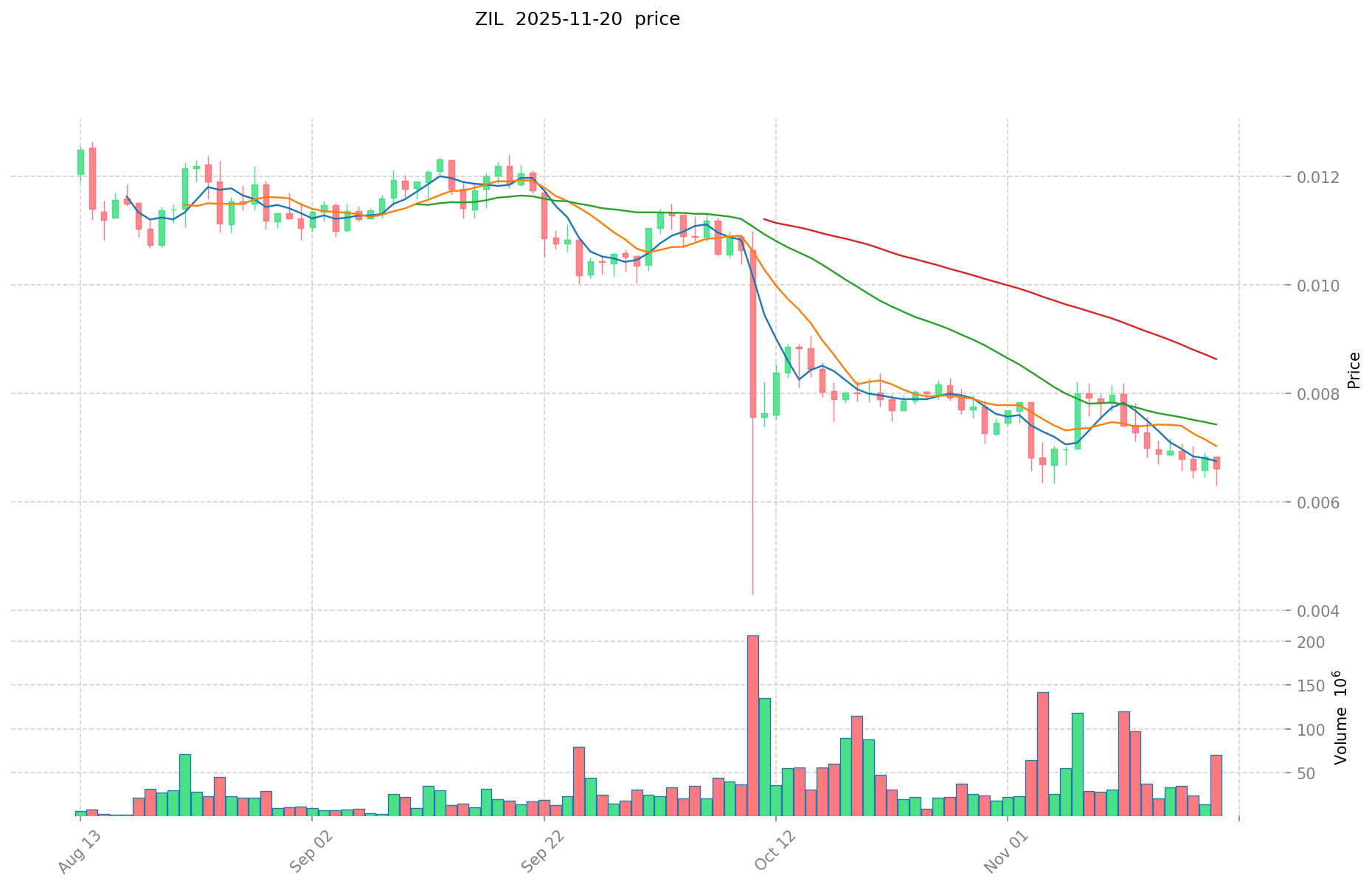AVAAI vs ZIL: The Battle for AI Supremacy in the Blockchain Era
Introduction: AVAAI vs ZIL Investment Comparison
In the cryptocurrency market, the comparison between AVAAI vs ZIL has always been an unavoidable topic for investors. The two not only show significant differences in market cap ranking, application scenarios, and price performance, but also represent different positions in the crypto asset landscape.
AVA (AVAAI): Launched as the first flagship AI agent through Holoworld AI, it has gained market recognition for its audiovisual AI capabilities.
Zilliqa (ZIL): Since its inception in 2018, it has been hailed as a high-throughput public blockchain platform, aiming to solve transaction speed and scalability issues.
This article will comprehensively analyze the investment value comparison between AVAAI and ZIL, focusing on historical price trends, supply mechanisms, institutional adoption, technological ecosystems, and future predictions, attempting to answer the question most concerning to investors:
"Which is the better buy right now?"
I. Price History Comparison and Current Market Status
AVA (Coin A) and ZIL (Coin B) Historical Price Trends
- 2025: AVA reached its all-time high of $0.338 on January 15, 2025, and its all-time low of $0.00339 on October 10, 2025, showing significant volatility within the year.
- 2021: ZIL hit its all-time high of $0.255376 on May 7, 2021, during the broader cryptocurrency bull market.
- Comparative Analysis: In the recent market cycle, AVA has experienced extreme price swings within a single year, while ZIL has been on a longer-term downtrend since its 2021 peak.
Current Market Situation (2025-11-21)
- AVA current price: $0.011494
- ZIL current price: $0.006257
- 24-hour trading volume: AVA $334,969.30 vs ZIL $269,848.69
- Market Sentiment Index (Fear & Greed Index): 11 (Extreme Fear)
Click to view real-time prices:
- View AVA current price Market Price
- View ZIL current price Market Price


II. Core Factors Affecting the Investment Value of AVAAI vs ZIL
Supply Mechanisms Comparison (Tokenomics)
-
AVAAI: Has a total supply of 10 billion tokens, with 3% allocated to presale, 7% to ecosystem, 90% locked in treasury for future emissions
-
ZIL: Maximum supply capped at 21 billion ZIL with a deflationary mechanism where transaction fees are partially burned
-
📌 Historical Pattern: Deflationary tokens like ZIL tend to perform better in bull markets when demand exceeds the decreasing available supply.
Institutional Adoption and Market Applications
- Institutional Holdings: ZIL has more established institutional backing with listings on major exchanges and inclusion in crypto indices
- Enterprise Adoption: ZIL has greater enterprise adoption through its Zilliqa blockchain platform serving various industries including fintech and gaming
- National Policies: Singapore has been supportive of Zilliqa's development, while AVAAI faces more regulatory uncertainty as a newer token
Technology Development and Ecosystem Building
- AVAAI Technology: Focuses on AI integration with blockchain technology, particularly in predictive analytics and automated trading
- ZIL Technology: Features sharding technology for scalability and the Scilla programming language designed for security in financial applications
- Ecosystem Comparison: ZIL has a more mature ecosystem with established DeFi protocols, NFT marketplaces, and staking mechanisms, while AVAAI's ecosystem is still in early development stages
Macroeconomic Factors and Market Cycles
- Performance in Inflationary Environments: ZIL has demonstrated better stability during inflationary periods due to its established market position
- Macroeconomic Monetary Policy: Both tokens show sensitivity to Federal Reserve decisions, with interest rate hikes typically causing short-term downward pressure
- Geopolitical Factors: ZIL's established presence in Southeast Asian markets provides some geographic diversification advantages over AVAAI
III. 2025-2030 Price Prediction: AVAAI vs ZIL
Short-term Forecast (2025)
- AVAAI: Conservative $0.0064204 - $0.011465 | Optimistic $0.011465 - $0.01570705
- ZIL: Conservative $0.00601536 - $0.006266 | Optimistic $0.006266 - $0.00726856
Mid-term Forecast (2027)
- AVAAI may enter a growth phase, with estimated prices of $0.01270021617 - $0.02230281864
- ZIL may enter a steady growth phase, with estimated prices of $0.007601008896 - $0.010213855704
- Key drivers: Institutional fund inflows, ETFs, ecosystem development
Long-term Forecast (2030)
- AVAAI: Base scenario $0.023596157544126 - $0.028551350628393 | Optimistic scenario $0.028551350628393+
- ZIL: Base scenario $0.011716396024378 - $0.012770871666572 | Optimistic scenario $0.012770871666572+
Disclaimer: The above predictions are based on historical data and market analysis. Cryptocurrency markets are highly volatile and subject to change. This information should not be considered as financial advice.
AVAAI:
| 年份 | 预测最高价 | 预测平均价格 | 预测最低价 | 涨跌幅 |
|---|---|---|---|---|
| 2025 | 0.01570705 | 0.011465 | 0.0064204 | 0 |
| 2026 | 0.017390112 | 0.013586025 | 0.011955702 | 18 |
| 2027 | 0.02230281864 | 0.0154880685 | 0.01270021617 | 34 |
| 2028 | 0.0262646665623 | 0.01889544357 | 0.0154942637274 | 64 |
| 2029 | 0.024612260022103 | 0.02258005506615 | 0.021225251762181 | 96 |
| 2030 | 0.028551350628393 | 0.023596157544126 | 0.012034040347504 | 105 |
ZIL:
| 年份 | 预测最高价 | 预测平均价格 | 预测最低价 | 涨跌幅 |
|---|---|---|---|---|
| 2025 | 0.00726856 | 0.006266 | 0.00601536 | 0 |
| 2026 | 0.0090681552 | 0.00676728 | 0.0051431328 | 8 |
| 2027 | 0.010213855704 | 0.0079177176 | 0.007601008896 | 26 |
| 2028 | 0.0131453906454 | 0.009065786652 | 0.00661802425596 | 44 |
| 2029 | 0.012327203400057 | 0.0111055886487 | 0.007218632621655 | 77 |
| 2030 | 0.012770871666572 | 0.011716396024378 | 0.00960744473999 | 87 |
IV. Investment Strategy Comparison: AVAAI vs ZIL
Long-term vs Short-term Investment Strategies
- AVAAI: Suitable for investors focused on AI integration and potential ecosystem growth
- ZIL: Suitable for investors seeking established blockchain platforms with proven scalability
Risk Management and Asset Allocation
- Conservative investors: AVAAI: 20% vs ZIL: 80%
- Aggressive investors: AVAAI: 60% vs ZIL: 40%
- Hedging tools: Stablecoin allocation, options, cross-currency portfolios
V. Potential Risk Comparison
Market Risks
- AVAAI: High volatility due to nascent market status and AI hype cycles
- ZIL: Susceptibility to overall crypto market trends and competition from other smart contract platforms
Technical Risks
- AVAAI: Scalability, network stability
- ZIL: Mining centralization, potential security vulnerabilities
Regulatory Risks
- Global regulatory policies may impact both differently, with AVAAI potentially facing more scrutiny due to AI integration
VI. Conclusion: Which Is the Better Buy?
📌 Investment Value Summary:
- AVAAI advantages: AI integration potential, high growth potential in emerging market
- ZIL advantages: Established ecosystem, proven technology, institutional adoption
✅ Investment Advice:
- New investors: Consider a conservative allocation favoring ZIL for its established market presence
- Experienced investors: Balanced portfolio with both tokens, adjusting based on risk tolerance
- Institutional investors: Strategic allocation to both, with emphasis on ZIL for current stability and AVAAI for future growth potential
⚠️ Risk Warning: Cryptocurrency markets are highly volatile. This article does not constitute investment advice. None
VII. FAQ
Q1: What are the main differences between AVAAI and ZIL? A: AVAAI is a newer token focused on AI integration with blockchain, while ZIL is an established blockchain platform known for its scalability and sharding technology. AVAAI has higher volatility and growth potential, while ZIL offers more stability and a mature ecosystem.
Q2: Which token has shown better price performance recently? A: AVAAI has shown more extreme price swings in 2025, reaching both its all-time high and low within the year. ZIL, on the other hand, has been on a longer-term downtrend since its 2021 peak.
Q3: How do the supply mechanisms of AVAAI and ZIL differ? A: AVAAI has a total supply of 10 billion tokens, with 90% locked in treasury for future emissions. ZIL has a maximum supply of 21 billion tokens with a deflationary mechanism where transaction fees are partially burned.
Q4: Which token has better institutional adoption? A: ZIL currently has more established institutional backing, with listings on major exchanges and inclusion in crypto indices. It also has greater enterprise adoption through its blockchain platform serving various industries.
Q5: What are the key factors affecting the long-term value of each token? A: For AVAAI, key factors include AI technology integration, ecosystem development, and market adoption of AI-blockchain solutions. For ZIL, factors include its scalability solutions, established ecosystem, and continued enterprise adoption of its blockchain platform.
Q6: How should investors approach allocating between AVAAI and ZIL? A: Conservative investors might consider allocating 20% to AVAAI and 80% to ZIL, while more aggressive investors could allocate 60% to AVAAI and 40% to ZIL. The specific allocation should be based on individual risk tolerance and investment goals.
Q7: What are the main risks associated with investing in AVAAI and ZIL? A: AVAAI faces risks related to high volatility, market nascency, and potential regulatory scrutiny due to AI integration. ZIL risks include susceptibility to overall crypto market trends, competition from other smart contract platforms, and potential mining centralization issues.
Share
Content